Body Positioning at Full Speed
by Steve McGill
In last month’s issue, I took a look at the technique of one of my athletes who was doing a cycling drill at slower speeds. This month, I want to take a look at a different athlete, who was doing some full-speed reps out of the blocks. Like I did last month, I’ll use screenshots from video that I took from one of the reps as the basis for my analysis. The athlete we’ll be looking at this month, Joshua Brockman, is a high school junior whom I coach privately. Last summer, before I started working with him, he ran 13.94 at the finals of the Junior Olympics in the 15-16 age group. Working with such an athlete, who has already achieved a high level of success, presents a different type of challenge than the one I am usually faced with, which involves raising a hurdler from puppy-hood.
[am4show not_have=’g5;’]
[/am4show][am4guest]
[/am4guest][am4show have=’g5;’]
With an athlete like Josh, the key is to make adaptations and corrections to his technique without compromising the strengths that have enabled him to succeed up to this point. Fortunately for me, Josh is a highly intelligent athlete, so I am able to engage him in dialogue that allows him to grasp the concepts I am teaching him while allowing him to help me understand the logic behind what he has done in the past.
The pics we’ll be looking at are from a session a few weeks ago, and he was coming out of the starting blocks on these. We’ll be looking at his clearance of hurdle one, at 39 inches. Let’s take a look:
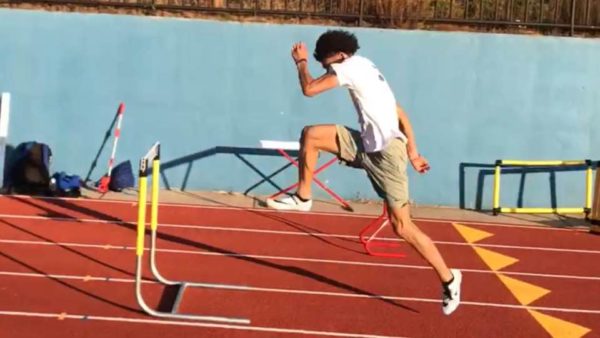 Okay, here we are at take-off in the above photo. He’s in good position here for the most part. The knee is driving at the crossbar, the ankle of the lead leg is dorsi-flexed so that the heel is under the hamstring, slightly behind the knee. Also, the knee is higher than the crossbar before the foot extends. He’s got a nice lean from the waist, which will be deeper as he continues his dive into the hurdle. Only thing wrong is that his hips are twisting slightly, and his lead arm is slightly going across his body. I’ll show you that more clearly later, with a pic from a different rep from the head-on angle.
Okay, here we are at take-off in the above photo. He’s in good position here for the most part. The knee is driving at the crossbar, the ankle of the lead leg is dorsi-flexed so that the heel is under the hamstring, slightly behind the knee. Also, the knee is higher than the crossbar before the foot extends. He’s got a nice lean from the waist, which will be deeper as he continues his dive into the hurdle. Only thing wrong is that his hips are twisting slightly, and his lead arm is slightly going across his body. I’ll show you that more clearly later, with a pic from a different rep from the head-on angle.
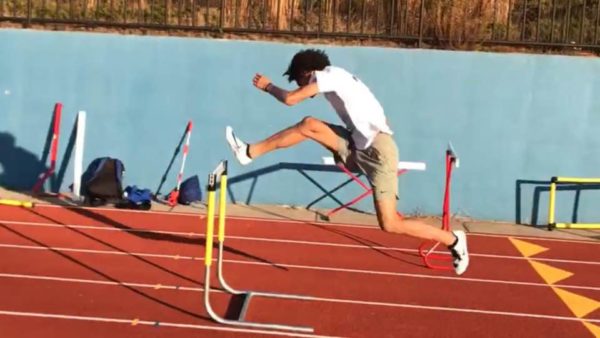 Okay, in the above pic, the heel has been released and is now attacking the crossbar. Notice that the knee stays slightly bent, and we want to take off closely enough that the knee can stay slightly bent instead of flattening out horizontally. The bend from the waist has increased, so that his chest is now right over his thigh. But the eyes stay up and chin stays up. Both ankles remain dorsi-flexed. The lead arm is beginning its descent, or punch-down. And that’s an important thing to keep in mind — the lead arm should begin its descent before the foot of the lead leg has crossed the barrier.
Okay, in the above pic, the heel has been released and is now attacking the crossbar. Notice that the knee stays slightly bent, and we want to take off closely enough that the knee can stay slightly bent instead of flattening out horizontally. The bend from the waist has increased, so that his chest is now right over his thigh. But the eyes stay up and chin stays up. Both ankles remain dorsi-flexed. The lead arm is beginning its descent, or punch-down. And that’s an important thing to keep in mind — the lead arm should begin its descent before the foot of the lead leg has crossed the barrier.
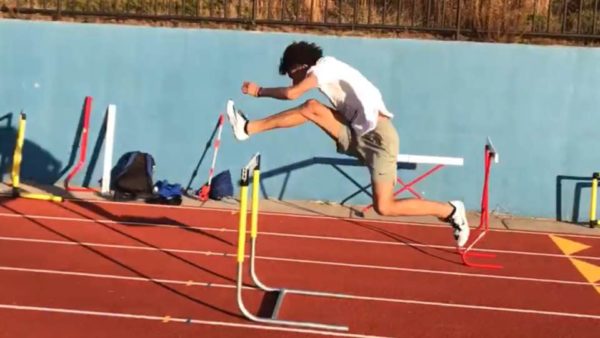 Now in the above photo, there is some good and bad. On the positive side, his lean has deepened even further, pushing him forward, which will cause acceleration off the hurdle. And his eyes are still up, allowing him not only to see where he is going, but to maintain control so that he won’t be top-heavy and stumble forward when he touches down. The knee of the lead leg remains slightly bent so that he can attack the track in a cycling motion that will allow the heel to land under the hip. On the negative side, he is clearing the hurdle higher than he needs to. In the previous photo, he already had the height he needed to begin cycling the foot downward without hitting the hurdle. But instead of cycling downward, he raised the foot a little higher, and we generally do not want that much space between the heel and the crossbar. That’s something we’ll need to work on.
Now in the above photo, there is some good and bad. On the positive side, his lean has deepened even further, pushing him forward, which will cause acceleration off the hurdle. And his eyes are still up, allowing him not only to see where he is going, but to maintain control so that he won’t be top-heavy and stumble forward when he touches down. The knee of the lead leg remains slightly bent so that he can attack the track in a cycling motion that will allow the heel to land under the hip. On the negative side, he is clearing the hurdle higher than he needs to. In the previous photo, he already had the height he needed to begin cycling the foot downward without hitting the hurdle. But instead of cycling downward, he raised the foot a little higher, and we generally do not want that much space between the heel and the crossbar. That’s something we’ll need to work on.
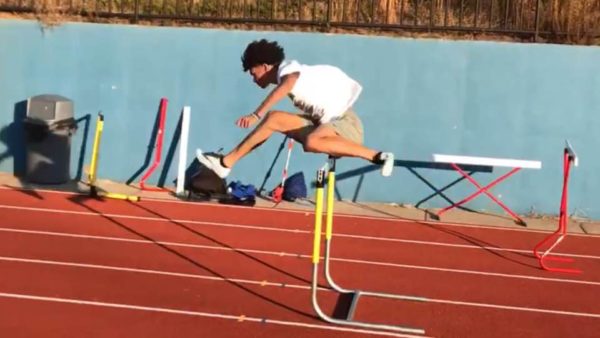 Again, we have some good and bad here. On the positive side, I love how he holds his lean throughout hurdle clearance, pushing himself forward. A lot of hurdlers come out of their lean too soon, leading them to lose all the momentum they gained by leaning in the first place. The trail leg is in great position, with the knee leading the way, nice and high above the crossbar, just like Liu Xiang used to do. The ankles remain dorsi-flexed, and the lead leg is cycling nicely, with the knee staying bent. On the negative side, we’d rather he’d be in this position when the knee of the lead leg has just passed the crossbar, not like it is here, with the butt of the lead leg being over the bar. So, he’s a little late with his descent, and that’s because of what we saw from the lead leg in the previous photo. The reason this matters is because it means he will land farther away from the hurdle he just cleared, and will be in the air longer, causing a slight decrease in velocity.
Again, we have some good and bad here. On the positive side, I love how he holds his lean throughout hurdle clearance, pushing himself forward. A lot of hurdlers come out of their lean too soon, leading them to lose all the momentum they gained by leaning in the first place. The trail leg is in great position, with the knee leading the way, nice and high above the crossbar, just like Liu Xiang used to do. The ankles remain dorsi-flexed, and the lead leg is cycling nicely, with the knee staying bent. On the negative side, we’d rather he’d be in this position when the knee of the lead leg has just passed the crossbar, not like it is here, with the butt of the lead leg being over the bar. So, he’s a little late with his descent, and that’s because of what we saw from the lead leg in the previous photo. The reason this matters is because it means he will land farther away from the hurdle he just cleared, and will be in the air longer, causing a slight decrease in velocity.
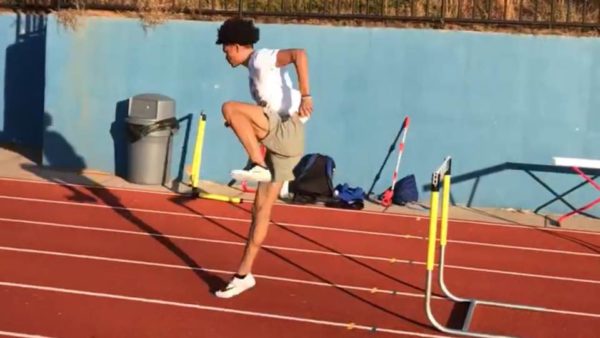 Now here we are at touchdown. As I mentioned in the last photo, he’s landing farther away from the hurdle than I would like, but that’s the only real issue I have here. So, be aware of how one mistake can have a domino effect. By raising his foot too high two photos ago, it has led to him landing farther away from the hurdle than we want to. But we’re looking good here in regards to landing on the ball of the foot, with the chest pushing forward, keeping that forward momentum going. The trail leg knee is nice and high, with the heel tucked. However, the knee is not all the way facing the front, and there is a slight twist in the hips, which was caused by the angle of the lead arm in the first photo. Let me go ahead and show you what I’m talking about with that in the next photo:
Now here we are at touchdown. As I mentioned in the last photo, he’s landing farther away from the hurdle than I would like, but that’s the only real issue I have here. So, be aware of how one mistake can have a domino effect. By raising his foot too high two photos ago, it has led to him landing farther away from the hurdle than we want to. But we’re looking good here in regards to landing on the ball of the foot, with the chest pushing forward, keeping that forward momentum going. The trail leg knee is nice and high, with the heel tucked. However, the knee is not all the way facing the front, and there is a slight twist in the hips, which was caused by the angle of the lead arm in the first photo. Let me go ahead and show you what I’m talking about with that in the next photo:
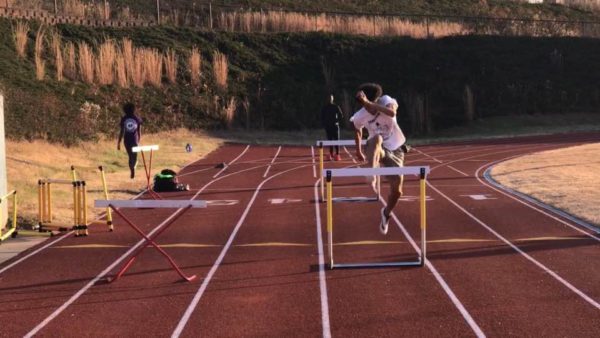 Okay, here it is. You can see how the upper body is tilting slightly to the lead leg side of the lean. That’s a David Oliver move that works for bigger hurdlers who ride their lead leg all the way down the track. But we don’t want that tilt; we want to keep everything pushing forward. Also, the lead arm is slightly going across the body. It’s not a major flaw, but it’s enough to prevent the trail leg knee from facing the front upon touchdown, as we saw in the last photo.
Okay, here it is. You can see how the upper body is tilting slightly to the lead leg side of the lean. That’s a David Oliver move that works for bigger hurdlers who ride their lead leg all the way down the track. But we don’t want that tilt; we want to keep everything pushing forward. Also, the lead arm is slightly going across the body. It’s not a major flaw, but it’s enough to prevent the trail leg knee from facing the front upon touchdown, as we saw in the last photo.
So, if a hurdler who is already run sub-14.00 can fix these minor flaws, he can drop a lot of time because, as we know, everything in the hurdles is times ten.
[/am4show]
